Tree frogs are one of the best species of frogs to keep as pets. They require little maintenance. And because of this, many frog keepers think it would be simple to keep several tree frogs as captives. However, whether you should keep them together or not has generated some significant debate in the frog ownership community.
The argument is that a zoo often recreates wild communities of reptiles and amphibians with large, elaborate exhibits. Can a home hobbyist combine different species of tree frogs to achieve the same results?
But can they make it work? The answer is both yes and no. It’s a complicated situation that I’ll explain in a few bits. In this article, you can find out more about the amphibian species that can coexist with one another, as well as the reasons why doing so is not a good idea.
Which tree frogs can live together?
Green tree frogs and gray tree frogs are the only two different species of tree frogs that can coexist properly because they share similar environments, care requirements, and toxic substances.
Some other tree frogs qualify for this as well, such as the Barking Tree Frog, the Red-eyed Tree Frog, and the White-lipped Tree Frog.
This doesn’t necessarily mean that these species can live together without considering their individual needs. It’s crucial to understand before combining species that keeping two species together typically increases the likelihood of problems than keeping them apart.
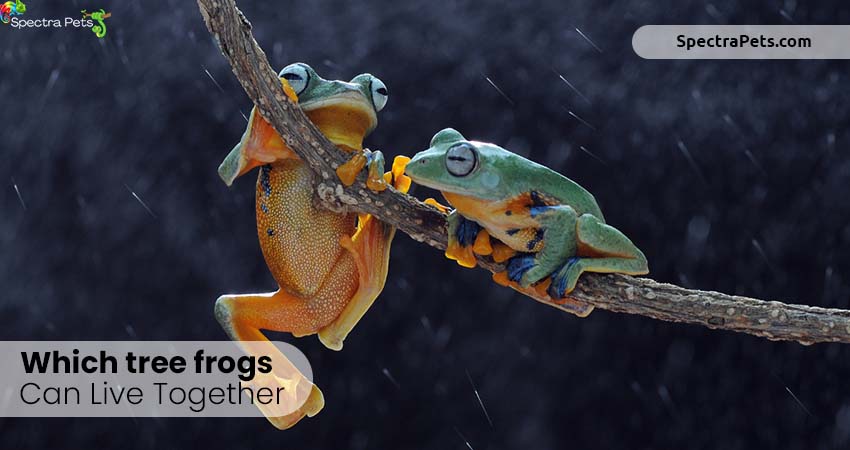
Can you mix different species of frogs?
Some species of tree frogs can coexist, while others cannot. The same species of tree frogs, however, can be kept in groups.
Certain species of tree frogs prefer to live alone. Tree frog species such as the green tree frogs and the white dumpy tree frogs can coexist in groups.
Hobbyists typically have trouble accommodating multiple species in one terrarium, so they should generally refrain from trying to do so and stick with species-specific setups.
When can you keep tree frogs together?
There are several key things you need to consider before you decide to mix up a variety of frog species in your terrarium. These are the following:
- Being aware of the species that can coexist
- Terrarium dimensions
- Size and cannibalism
- Care differences
- Conflicting requirements for environment
- Toxicity
- Nutritional variations
- Breeding
- Diseases
To help you better understand these factors, let’s explore them further…
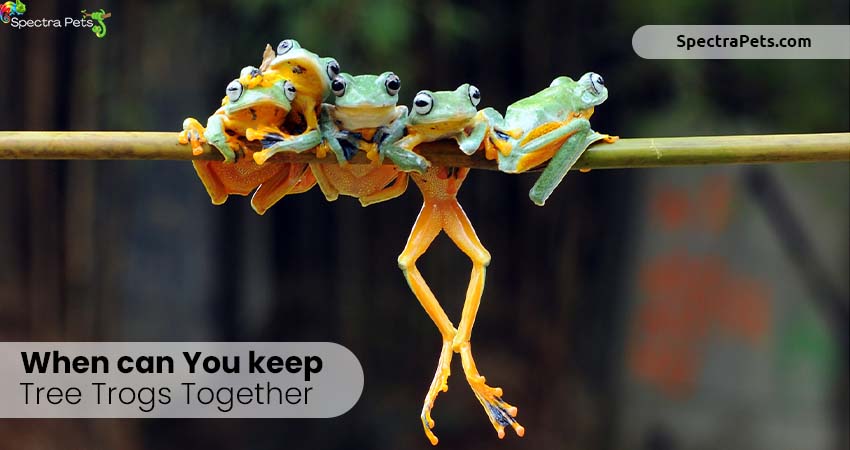
Being aware of the species that can coexist
You should be aware of tree frog species that can coexist before building a communal tank. Some tree frog species can coexist peacefully and amicably with other amicable species.
Some species enjoy coexisting with other species while still young. But once they become mature, you must move them to a different tank.
A few frogs that can live together are the American Green Tree Frog, Gray Tree Frog, Barking Tree Frog, White-lipped Tree Frog, and the Red-eyed Tree Frog. However, that does not imply that they can always coexist in the same terrarium. There are still many things to consider.
For example, big-eyed tree frogs are frequently grouped with these species. That is one awful error. As they are typically smaller and cannot coexist with other species.
Terrarium Dimensions
The most common mistake made when keeping a collection of reptiles and amphibians in a terrarium is the size of the enclosure. It’s crucial that every animal in the cage has enough space to roam freely, find food on its own, regulate its body temperature, and otherwise behave normally without the risk of conflict from aggressive cage mates.
When keeping multiple species together, standard aquarium sizes are too small to achieve this, and the long, low rectangular shape that most are manufactured in is rarely appropriate for this use.
The next time you visit a zoo that has a display with a number of species together, pay attention to how big the enclosure is. Most are large cubes with dimensions of several feet or more in length, width, and height. If you keep variations of reptiles and amphibians in the same cage at home, you can use a similar cage size.
It’s also critical to realize that a terrarium provides less space than the natural world. There is ample room for reptiles and amphibians to conduct their daily activities in the wild.
Unless one species is attempting to devour another, two species rarely come into contact. Even when species coexist in nature, there is a higher likelihood that something will go wrong when multiple species are enclosed in a small glass container.
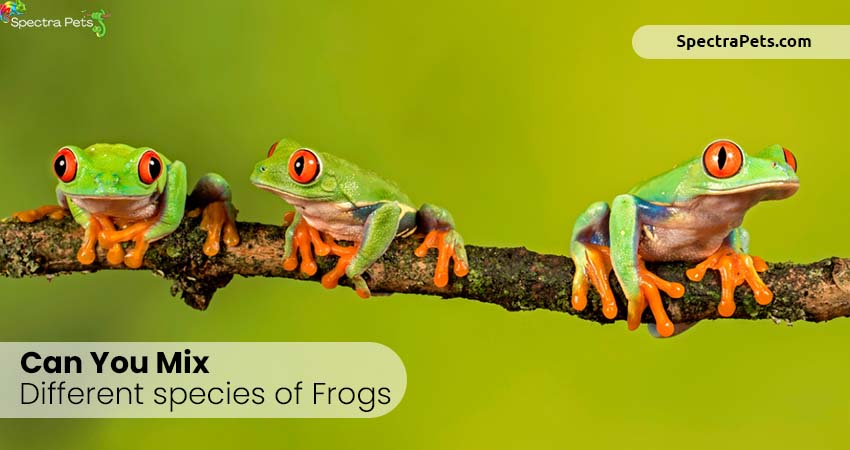
Size and Cannibalism
Frogs are cannibal creatures that prey upon their own kind and even their own tadpoles. It’s amazing what size of prey a frog can fit into its mouth.
Even though some species can coexist, their size is a key factor in this situation. Keeping frogs larger than 4 inches and smaller than 3 inches apart is the best practice.
Care Differences
A lot of tree frogs have unique needs compared to others. That is why maintaining a group of tree frogs is so difficult.
You must be aware of those species’ husbandry requirements. While some tree frogs are active during the day and don’t need much water or food, others are nocturnal and don’t.
Many varieties of tree frogs are faster, more ferocious, and stronger than others. Their eating patterns are directly affected by it. It prevents the food from being distributed properly inside the tank. The smaller ones will become physically weak and malnourished as a result.
Make sure all the tree frogs require the same level of attention and care before grouping them.
Conflicting Requirements for Environment
It can be challenging and occasionally impossible to accommodate the various environmental requirements of multiple species in one enclosure. Keeping different species together is not a good idea if their environmental requirements are not compatible.
Many owners of tree frogs think it’s simple to make one large terrarium for all of their frogs rather than individual enclosures. But making this decision is never simple. It takes a lot of knowledge and money to create a terrarium that can accommodate different species of tree frogs.
It’s challenging because you risk endangering other occupants if you attempt to repair every facility in a single enclosure. One crucial element in this is temperature. The majority of tree frogs need colder temperatures than the others. So you have to keep an optimum temperature for both frog species.
Some species of tree frogs need UVB lighting, while others don’t. Therefore, when creating a terrarium, be sure to include a UVB light source and avoid completely covering the tank top with glass.
Toxicity
Toxicity is an often overlooked issue. For obvious reasons, keeping poisonous amphibian species with other animals is dangerous.
Through their skin, frogs release some kind of toxic material. According to the species, the poison is different. Their skin allows them to absorb almost everything. As a result, whenever a frog secretes poison to harm another frog, it unintentionally takes the poison in.
Although there might not be a noticeable effect right away, it gradually interferes with a frog’s normal physiological processes.
A frog typically lives for 16 to 25 years in captivity. However, it will gradually decrease as more poison from other tree frogs is absorbed. The frog will deteriorate and likely stop eating.
Therefore, before mixing different species of tree frogs, make sure their poisons won’t conflict.
Nutritional Variations
Even though they are roughly the same size, inhabit comparable habitats, are not poisonous in captivity, and would presumably get along just fine if kept together, some amphibians occasionally struggle because they need different kinds of food. One of the most crucial aspects of keeping amphibians in captivity is their diet.
It is unfortunate that not all species consume the same foods, and those that do frequently, do not consume the same quantities of food.
Red-eyed tree frogs and green and black poison dart frogs, for instance, live in habitats that are similar, are not particularly aggressive, are not poisonous in captivity, and otherwise, seem like they might get along well.
However, their dietary needs differ greatly in terms of captive care. While dart frogs can only consume the smallest of prey, tree frogs will only recognize larger invertebrates as food.
Although feeding both sizes of food is one solution, this might not work out well because large feeder insects like crickets that go unnoticed might try to harm amphibians and reptiles who don’t eat them first. In the aforementioned scenario, the red-eyed tree frogs could potentially harm the dart frogs.
It’s also critical to realize that not all amphibians have the same capacities for hunting. When kept together, stronger species will outcompete weaker species by intimidating them away from food.
Read More: Can you keep tree frogs with dart frogs?
Breeding
You should never keep other tree frogs in that terrarium if you plan to breed your tree frog pair. To entice female mates, male frogs often compete with one another.
Therefore, if you keep several male frogs together in a tank, the croaking will be very loud. Additionally, male tree frogs attempt to assert their dominance over one another. Therefore, it is advisable to only keep one male tree frog in each gallon.
Frogs in general, including tree frogs, do not exhibit parental behavior after their eggs hatch. They could consume their own tadpoles. Thus, keeping an additional frog will make the risk even greater.
Diseases
Finally, it’s crucial to note that combining different species—especially those from various sources or field-collected reptiles and amphibians from various regions—increases the possibility of the transmission of foreign pathogens.
It is necessary to keep the two species apart for a while to ensure their health before mixing different species. However, even in cases where both species appear healthy, it is still possible that one may be carrying a disease that the other is particularly susceptible to. Usually, two or three months of isolation is sufficient to detect a health issue. A vet can help lower this risk by performing a health examination.
Can you keep multiple tree frogs of the same species together?
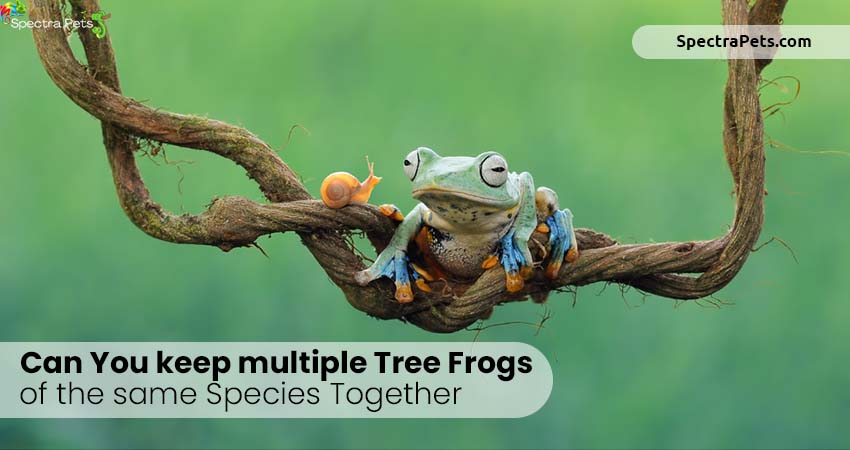
Sometimes, you like to have not only one but a group of tree frogs of the same species. Maybe because you like uniformity or that specific species is dear to you. In times like these I’m sure that has been a worry at the back of your head – will they get along?
The answer is yes, although this is not the case in every situation. Some species of tree frogs prefer to live alone.
In general, it is a better option than combining different species. The same species of frogs need the same environmental conditions, enclosure, care, and diet.
It’s never a good idea to keep different frog species together. But if you’re serious about it, be sure to keep an eye on them every day. Check to see if the other frogs’ presence is stressing them out. Stress in frogs can lead to severe problems and even death. Observe them closely for changes in diet, behavior, appearance, color, and croaking.
Can two male frogs live together?
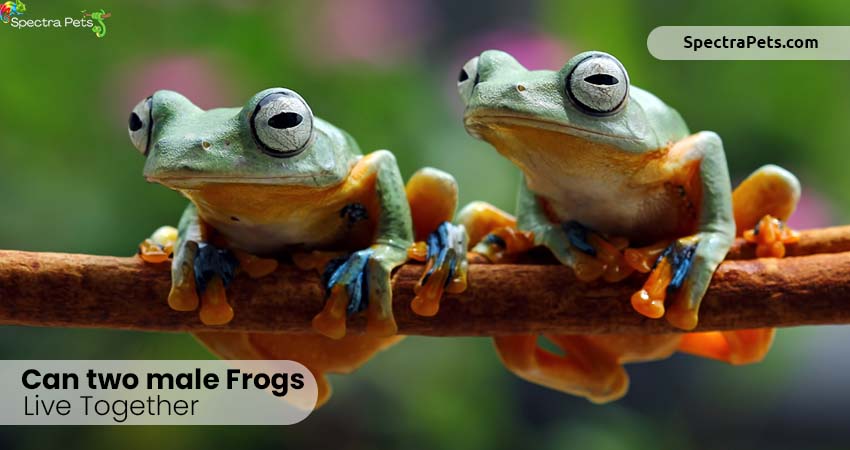
Two male frogs, regardless of their species, should not be kept together. This is because there is always competition between male frogs to attract females.
Can two female frogs live together?
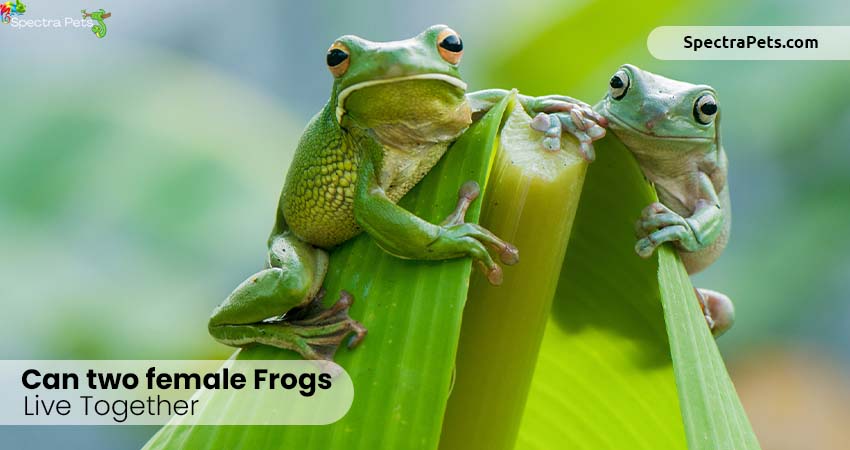
In most cases, yes, provided that your enclosure is big enough and has lots of hiding spots; for example, two hides in the warm or basking area and two on the cold end.
Things to consider before keeping different species together
It is crucial to isolate all animals in individual enclosures before housing different species together to guarantee their well-being.
During this period of time, observe all animals carefully. In a solitary setting, the enclosures should be kept as hygienic as possible, and it is suggested that the keeper wash their hands and any shared equipment between cages to stop potential pathogens from spreading. Utilize specialized tools and gloves for best results.
Whenever possible, I also advise having a vet check out any new pets. This is crucial if the pets are meant to live in an enclosure alongside pets of a different species.
Always choose a captive-bred stock from a reputable breeder instead of mixing wild-caught animals. Amphibians born in captivity are less likely to have health issues than those that were recently gathered from the wild, and they may also be less likely to harbor dangerous diseases.
Additionally, using wild-caught amphibians for display raises ethical and moral concerns. The dangers of maintaining a community amphibian terrarium can be minimized by only mixing animals that have been raised in captivity.
Wrapping Up
I’m sure after reading the whole thing, you have a much clearer idea about which tree frogs can live together inside a terrarium. Usually, only expert frog keepers should be the ones doing that.
You have to remember, you don’t have trained individuals, like a Zoo. That’s why, keep your tree frogs separately until you understand what you’re doing. When you have a good idea of which tree frogs get along, then you can start to be more diverse.

